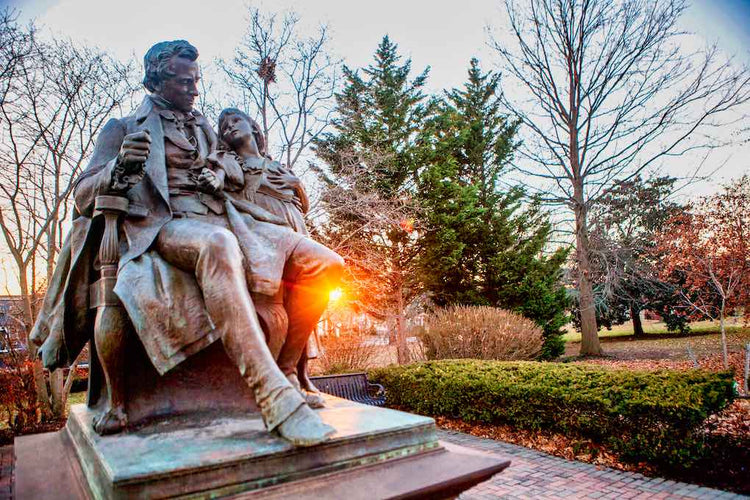
The Gallaudet Legacy: Pioneers Who Unlocked the World for Deaf Educati

Image Source: 1990-2025 ABILITY Magazine
In the heart of Washington, D.C., Gallaudet University stands as a beacon of empowerment for Deaf and hard-of-hearing individuals worldwide. But its story begins with two visionary men—father and son—whose relentless dedication reshaped the landscape of Deaf education.
Thomas Hopkins Gallaudet (1787–1851)
-
A Fateful Encounter Sparked a Mission
- In 1814, Thomas met Alice Cogswell, the 8-year-old deaf daughter of his neighbor, Dr. Mason Cogswell. Moved by her isolation (no schools for deaf children existed in the U.S. at the time), he vowed to find a way to educate her. This led to his landmark trip to Europe to study deaf education methods.
-
A Historic Partnership with a Deaf Educator
- In Paris, he convinced Laurent Clerc, a deaf instructor at the Royal Institution for Deaf-Mutes, to return to America with him. Clerc was the first deaf person to cross the Atlantic Ocean intentionally (1816). Together, they co-founded the American School for the Deaf (1817) in Hartford, CT—the U.S.’s first permanent school for deaf children. Their collaboration blended French Sign Language (LSF) with local American signing traditions, planting the seeds for American Sign Language (ASL).
-
He Almost Became a Minister
- Before dedicating himself to deaf education, Thomas studied theology and was ordained as a Congregational minister. His religious background influenced his belief in the moral and intellectual potential of deaf individuals, arguing they deserved education as “children of God.”
-
A Reluctant Celebrity
- Though he preferred teaching and writing over public fame, Thomas became a national figure in deaf education. He authored A Concise System of Instruction for the Deaf and Dumb (1832), one of the first textbooks for deaf students in America.
Edward Miner Gallaudet (1837–1917)
-
Took the Reins at a Remarkably Young Age
- Edward became superintendent of the Columbia Institution for the Deaf and Dumb and Blind (predecessor to Gallaudet University) in 1857 at just 20 years old, after the sudden death of his older brother, who was originally slated for the role. He would lead the institution for 46 years, transforming it into a degree-granting university.
-
A Champion of Sign Language Against Global Pressure
- At the 1880 Milan Conference in Italy, global educators voted to ban sign language in favor of “oralism” (teaching deaf students to speak and lip-read), claiming sign language was “primitive.” Edward refused to comply, defiantly stating, “Deafness, though it be total and congenital, imposes no limits on the intellectual development of its subjects.” His resistance kept ASL alive as a core teaching tool at Gallaudet, preserving deaf cultural identity.
-
A Presidential Connection
- Edward personally lobbied President Abraham Lincoln to grant the Columbia Institution the right to award college degrees. Lincoln signed the charter in 1864, making it the first university for deaf students in the world. The school was later renamed Gallaudet College in 1894 (and University in 1986) to honor his father, Thomas.
-
A Campus Landmark as a Home
- Edward lived in House One (built 1869), a 35-room Victorian Gothic mansion on campus, for nearly 50 years. The home, now a National Historic Landmark, features a secret staircase he used to slip into campus meetings unnoticed and a dining room where he hosted deaf activists and scholars from around the world.
-
A Family Legacy of Advocacy
- Edward’s daughter, Mabel Gallaudet Hubbard, married Alexander Graham Bell (inventor of the telephone). Though Bell later supported oralism (clashing with Edward’s beliefs), the family bond remained, and Mabel became a patron of deaf causes.
Shared Legacy & Quirks
- A Statue Frozen in Time: The campus statue of Thomas Hopkins Gallaudet and Alice Cogswell, sculpted by Daniel Chester French (who later created the Lincoln Memorial), was unveiled in 1889. Alice is depicted handing Thomas a bouquet, symbolizing the “gift” of her story inspiring his life’s work.
- Lifelong Learners: Both men mastered multiple sign languages—Thomas knew French Sign Language and early ASL, while Edward was fluent in ASL and studied Indigenous signing traditions of the Plains tribes.
- Defying Labels: They rejected the term “dumb” (then used to mean “mute”) in educational institutions, advocating for “deaf” as a proud identity—a radical stance in their era.
Their lives were a testament to perseverance: Thomas turned a single child’s need into a national movement, while Edward fought to elevate Deaf education to collegiate heights, resisting forces that sought to erase deaf culture. Together, they didn’t just build schools—they built a legacy of dignity and empowerment that echoes at Gallaudet University today.
FAQ
How did the Gallaudets contribute to the creation of American Sign Language (ASL)?
Thomas Hopkins Gallaudet partnered with French deaf educator Laurent Clerc in 1816, bringing French Sign Language (LSF) to America. At the American School for the Deaf (1817), they merged LSF with indigenous signing traditions used by local deaf communities, laying the groundwork for ASL. Edward Miner Gallaudet later defended sign language against the oralism movement (which aimed to eliminate it), ensuring ASL remained central to Gallaudet’s curriculum and Deaf cultural identity.
What was Edward Miner Gallaudet’s biggest challenge in advancing deaf education?
Edward’s defining battle was against the 1880 Milan Conference, where global educators voted to replace sign language with oralism (teaching deaf students to speak and lip-read), claiming it was more “civilized.” Despite pressure—including from his son-in-law Alexander Graham Bell, a oralism supporter—Edward refused to abandon sign language, declaring deaf individuals could thrive intellectually with sign language. His defiance preserved ASL and Deaf cultural autonomy at Gallaudet.
Are there physical tributes to the Gallaudets on Gallaudet University’s campus?
Yes! The campus features:
Thomas Hopkins Gallaudet & Alice Cogswell Statue (1889), sculpted by Daniel Chester French, depicting their pivotal meeting that inspired Thomas’s life work.
Edward Miner Gallaudet Residence (House One), a Victorian Gothic mansion where he lived for 50 years, now a National Historic Landmark. It symbolizes his lifelong commitment and includes a secret staircase he used for discreet campus access.
Use left/right arrows to navigate the slideshow or swipe left/right if using a mobile device

